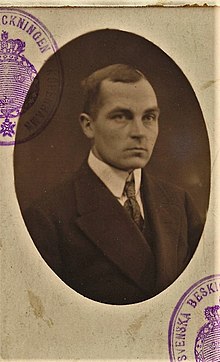Horst von Pflugk-Harttung (original) (raw)
From Wikipedia, the free encyclopedia
German intelligence officer and spy
Horst von Pflugk-Harttung Portrait (1919)
Horst Gustav Friedrich von Pflugk-Harttung (17 June 1889 – 9 March 1967)[1] (alternate spelling Pflug-Hartnung) was a German intelligence officer and spy.[2]
After serving in the army during the World War I, Pflugk-Harttung had become a member of the Freikorps, the paramilitary organizations that sprung up around Germany as soldiers returned in defeat from the war. The Freikorps were the key paramilitary groups active during the Weimar Republic. Many German veterans felt disconnected from civilian life and joined a Freikorps in search of stability within a military structure. Kapitänleutnant Pflugk-Harttung, along with his brother, Heinz, were two such volunteers. The German volunteer movement was opposed to the communist Spartacists movement. During this period, he became friends with the future head of the Abwehr, Wilhelm Canaris. In 1919, Pflugk-Harttung, along with his brother, was accused of being directly involved in the murder of the Spartacist Karl Liebknecht.[3] Both men were acquitted, but many evidently thought them guilty, with Horst secretly admitting his guilt to Ernst von Weizsäcker. His brother died in an accidental explosion from a grenade in 1920.[4]
In 1931, Pflugk-Harttung was recorded as helping to co-ordinate fascist groups and organisation in Sweden. The Swedish authorities had Pflugk-Harttung expelled after they discovered that he had been importing armaments illegally into Sweden for Munckska kåren.[5] Pflugk-Harttung then went to Norway on a similar mission, but again, he was soon asked to leave.
By 1933 Pflugk-Harttung was working for German intelligence in Denmark. As a cover, he worked as correspondent for Berliner Boersen Zeitung, which was a newspaper of the Reich War Ministry. His duties included many covert tasks, one being keeping a close eye on the German exiles in Denmark, with the Danish police co-operating with him by using go-betweens. Along with other postgraduates of Gestapo spy schools, Pflugk-Harttung set up a spy ring that operated secret broadcasting stations and had engaged in nautical and hydrographical research. It had drawn up maps and charts, graphs and complicated mathematical tables of data, which required the best technicians even to understand. They communicated by complex code systems, which changed frequently. The outlay for such an extensive apparatus could be justified only as part of the Third Reich's preparation for war against major countries. Pflugk-Harttung's network watched and reported on British shipping movements into and out of the Baltic Sea. In 1938, information revealed by Ernst Wollweber to the Danish authorities, along with further investigations by the police led to the arrest of Pflugk-Harttung,[6][7] along with eight other Germans and three Danes, who were charged with operating as spies in Copenhagen. Investigations proved that the spy ring had been involved in the sabotage and sinking of Spanish trawlers on behalf of General Francisco Franco and his Nationalist Navy, which was operating from German ports. The acts included the use of the spying apparatus to shell and sink the SS Cantabria off the Norfolk coast by the Nationalist auxiliary cruiser Nadir.
For his part in the espionage, Pflugk-Harttung was sentenced to only 18 months in prison. He was released after a few months due to pressure from the German government. After his release from prison, Pflugk-Harttung was deported, and became one of the leading German intelligence chiefs in Denmark.
In 1944, Pflugk-Harttung was in control of the Marinesonderdienst in Bordeaux.[8] He was arrested by US forces and taken to Arizona as a prisoner-of-war.[8] He was held in American custody, then British custody, until November 1947 and then returned to Germany.[9]
- ^ "Kurzbiographien der Personen in den "Akten der Reichskanzlei, Weimarer Republik"".
- ^ "MI5 released file ref KV 2/2643-2644". Archived from the original on 2008-08-29. Retrieved 2008-06-30.
- ^ Armies of Spies, Author: Joseph Collomb, Published in 1939 by Macmillan, New York. Chapter 5, Franco's Fifth Column, page 88
- ^ Wiegrefe, Klaus (2010-03-14). "(S+) Der stille Revolutionär". Der Spiegel (in German). ISSN 2195-1349. Retrieved 2023-10-24.
- ^ "Inrikespolitisk översikt". Svenska Dagbladets Årsbok. Vol. 9. Svenska Dagbladet. 1932. p. 88 – via Project Runeberg.
- ^ Armies of Spies, Author: Joseph Collomb, Published in 1939 by Macmillan, New York. Chapter 5, Franco's Fifth Column, page 89
- ^ "Mike Jones on Danish Trotskyism". Archived from the original on 2009-02-27. Retrieved 2008-07-02.
- ^ a b National archives German intelligence officers
- ^ Siehe das Schreiben von Horst von Pflugk-Harttung an Waldemar Pabst, 3. Mai 1962, in: Klaus Gietinger: Eine Leiche im Landwehrkanal. Die Ermordung der Rosa L. Berlin 1995, S. 134–136, S. 134.
- Singer, Kurt. Spies and Traitors of World War II. New York: Prentice-Hall, 1945. (Chapter 13)
